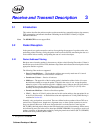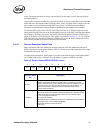
Receive and Transmit Description
Software Developer’s Manual 25
3.2.4 Receive Descriptor Fetching
The descriptor fetching strategy is designed to support large bursts across the PCI bus. This is made
possible by using 64 on-chip receive descriptors and an optimized fetching algorithm. The fetching
algorithm attempts to make the best use of PCI bandwidth by fetching a cache line (or more)
descriptors with each burst. The following paragraphs briefly describe the descriptor fetch
algorithm and the software control provided.
When the on-chip buffer is empty, a fetch happens as soon as any descriptors are made available
(software writes to the tail pointer). When the on-chip buffer is nearly empty
(RXDCTL.PTHRESH), a prefetch is performed whenever enough valid descriptors
(RXDCTL.HTHRESH) are available in host memory and no other PCI activity of greater priority
is pending (descriptor fetches and write-backs or packet data transfers).
When the number of descriptors in host memory is greater than the available on-chip descriptor
storage, the chip may elect to perform a fetch which is not a multiple of cache line size. The
hardware performs this non-aligned fetch if doing so results in the next descriptor fetch being
aligned on a cache line boundary. This mechanism provides the highest efficiency in cases where
fetches fall behind software.
Note: The Ethernet controller never fetches descriptors beyond the descriptor TAIL pointer.
Figure 3-1. Receive Descriptor Fetching Algorithm
On-chip
descriptor cache
is empty
On-chip
descriptor cache <
RDXCTL.PTHRESH
Descriptors
are available in
host memory
Valid descriptors
in host memory >
RXDCTL.HTHRESH
Pre-fetch (based
on PCI priority)
Fetch
No
Yes
Yes
No No
Yes Yes


















